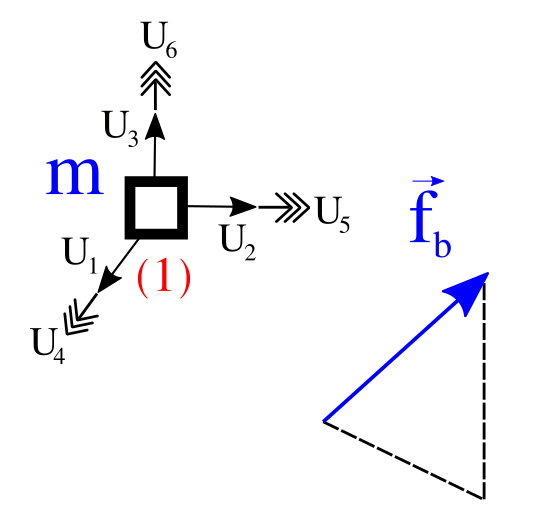Represent a vector of mass forces that is applied on a Node object. This force is represented by a magnitude and a direction of a field such that \(\textbf{F}= m_n \, \textbf{f}_b\). The Load object created in this manner is assembled directly to the global force vector, thus its direction must coincide with the Node's number of degree of freedom.

REFERENCE:
The python Pre-Analysis in the 01-Pre_Process/Method/Attach.py file provides with an interface to create a STATIC POINT BODY LOAD. For example, to create a Static point-body-load using json format, use:
addLoad(tag, name='PointLoad', attributes):
Example
A STATIC POINT BODY LOAD can be defined using the python interface as follows:
SVL.addLoad(tag=1, name='PointLoad', attributes={'fun': 1, 'type': 'Body', 'list': [1]})
The information required to define the magnitude and direction of the field where the load will act on. This information is provided in the attributes['fun'] identifier. Thus, to create a CONSTANT FUNCTION using the json format, use:
addFunction(tag, name, attributes):
Example
A CONSTANT FUNCTION can be defined using the python interface as follows:
SVL.addFunction(tag=1, name='Constant', attributes={'mag': 10.00, 'dir': [0.0, 0.0, -1.0]})
Application
This load has not been validated yet.
On the contrary, the 01-Pre_Process/Method/Remove.py file provides with an interface to depopulate the Entities dictionary. For example, to remove an already define Load, use:
Now, to remove a already defined function, use:
The C++ Run-Analysis in the 02-Run_Process/05-Loads/Load.cpp file provides the class implementation. A STATIC POINT BODY LOAD is defined inside the "Loads" json field indicating its "Tag" as follows,
{
"Loads": {
"Tag": {
"name" : "POINTLOAD",
"attributes": {
"name": "CONSTANT",
"type": "BODY",
"mag": double,
"dir": [ ],
"list": [ ]
}
}
}
}
| Variable | Description |
|---|---|
Tag | Unique load object identifier. |
mag | Magnitude/intensity of the applied force, traction or body load. |
dir | Vector containing the direction of the force. |
list | List of Node identifiers that share this load. |
dir must be consistent with the number of degree-of-freedom of that Node. A 3D STATIC POINT BODY LOAD applied downwards on node 2 whose intensities is 0.75 N:
{ "Loads": { "1": { "name" : "POINTLOAD", "attributes": { "name": "CONSTANT", "type": "BODY", "mag": 0.75, "dir": [0.000, 0.000, -1.000], "list": [2] } } } }